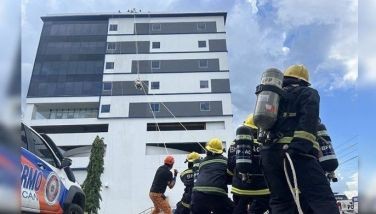Reclamation frenzy

Last Saturday I went to Taytay to buy raw balut and runny penoy higop to cook at home, plus extra-jumbo eggs and freshly prepared salted duck eggs.
The Circumferential Road 6 from Lower Bicutan to Taytay provided a smooth drive. But it was dismaying to see how muddy brown the water of Laguna de Bay had become.
It was a sunny day and the bright blue sky should have been reflected on the lake that is one of the sources of fresh water for west zone concessionaire Maynilad.
Instead the lake looked shallow and heavily silted from the proliferation of private fishpens. No wonder there are always water service interruptions in this zone, due to the extra work needed to purify and eliminate turbidity in the water.
C-6 Road was touted as a scenic lakeside drive. But these days you’ll have to crane your neck to see the water, as the former lakefront is now chock-full of ugly reclamation projects. The patches of remaining water near the road are overgrown with water lilies. It’s an ugly, dismaying sight.
C-6 veers northeastward alongside the Pasig River. The riverside would be a great area to develop into a commercial / recreational area, like similar waterfront spots in sustainable cities abroad. But there’s no visible effort along this line. Perhaps the local governments are more interested in identifying portions of the river with reclamation potential.
Apart from ruining the quality of water in the lake, indiscriminate reclamation in what is supposed to be a natural floodplain has worsened flooding around the lakefront communities. In low-lying areas of Muntinlupa, it can take up to three months for floodwaters to subside.
* * *
The reclamation frenzy is even more intense in Manila Bay. The Department of Environment and Natural Resources should be at the forefront of reviving the bay and protecting its marine biodiversity. Instead, according to fisherfolk group Pamalakaya, the DENR has issued environmental clearances for several massive bay reclamation projects.
These cover, among others, 420 hectares in Bacoor, Cavite; 2,500 hectares for an “aerotropolis” in Bulacan; 360 hectares in Pasay; 65 hectares in Navotas and 419 hectares for the Horizon Manila.
What will be left of the bay?
Defending its project, the Pasay government has explained that the city wants to expand its area and earn from the business revenues that are expected to be generated from the new development.
Rodrigo Duterte scuttled all reclamation projects in Manila Bay during his presidency. Instead he tasked his environment chief Roy Cimatu to do for Manila Bay what was done for Boracay. But there were suspicions that the cleanup was meant to pave the way for the reclamation projects. Also, the synthetic dolomite beach in Manila’s Baywalk was created during his watch.
Is President Marcos aware of the massive reclamation projects in Manila Bay and Laguna de Bay? Is decision making on projects that endanger the environment now left entirely to local government executives, many of whom have personal vested interests in such projects?
Manila Bay keeps getting smaller, threatening to worsen perennial flooding in Metro Manila and other surrounding areas, and destroying the already much reduced fish catch. Development projects have already decimated the salt beds around the bay. One day in the not-so-distant future, all that reclamation may make the bay too small even to function as an international and domestic port.
* * *
Marcos’ mom Imeldific started the reclamation frenzy with the Cultural Center of the Philippines complex and the Dagat-Dagatan housing project in Malabon-Navotas that worsened flooding in northern Metro Manila.
BBM has yet to make clear his stand on the ongoing reclamation projects and other environmental issues. But the Marcoses, as political kingpins of Ilocos Norte, have supported renewable energy projects particularly wind power, and have shown appreciation and respect for heritage structures.
Is there political will, however, to stop the current reclamation projects, most of which are being pushed by supporters of the administration?
One of BBM’s staunch political allies, at least, has been waging a spirited battle against Manila Bay reclamation.
Sen. Cynthia Villar has successfully turned a stretch of the bay from Parañaque to Las Piñas into an internationally protected critical wetland and ecotourism park – the only one of its kind in the entire Metro Manila.
The Villars have had their share of controversies. The clan’s turf Las Piñas, once home to extensive salt beds, has not been spared from indiscriminate development.
Still, a different type of reclamation has been carried out in recent years by the local government in Las Piñas. Rivers, creeks and other waterways have been dredged and cleaned, with structures encroaching on them dismantled. The larger waterways have been developed into river drives with riprapped banks, providing alternate routes to ease traffic in the city.
The waterways are cleaned regularly by uniformed personnel; you won’t ever see any overgrowth of water lilies. Taguig should ask Las Piñas how to turn water lilies into useful items such as hats, handbags and slippers. Such projects provide livelihoods while cleaning up waterways.
* * *
Instead of reclaiming precious bodies of water to expand the ugly concrete jungle that is Metro Manila, local governments in the country’s capital region should restore the waterways in their respective jurisdictions, clean these up and develop them into open spaces where people can hang out and relax.
Metro Manila, with its unplanned development and urban blight, has an acute lack of these open spaces, which promote physical and mental well-being. The demand for such open spaces is evident in the popularity of the few shore areas in Manila Bay still open to the public as well as open-air weekend flea markets where people congregate with children, grandparents and fur babies in tow.
BBM, who studied in the UK and must be familiar with life in sustainable cities, and his wife Liza who worked in New York surely appreciate the value of intangibles, such as the beauty of a clean, peaceful bay.
Sadly, all this ongoing reclamation is giving a new dimension to the image of the sun setting over Manila Bay. Perhaps it’s not yet too late to stop the madness.
- Latest
- Trending





























